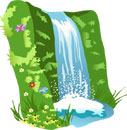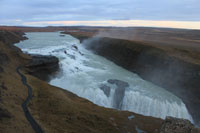
 Waterfall Falls Facts for Kids Waterfall Falls Facts for Kids
Enjoy our fun waterfall facts for kids. Learn interesting information about waterfalls including where they are found, how waterfalls form, different types, how they are used to produce electricity and much more. Read on to find out everything you’ve ever wanted to know about waterfalls! | | |
Erosion plays an important part in the formation of waterfalls. As a stream flows, it carries sediment that can erode the soft bed rock (limestone and sandstone) underneath. Eventually this cuts deep enough so that only harder rock, such as granite, remains. Waterfalls develop as the granite forms cliffs and ledges.
Waterfalls themselves also contribute to erosion. Stream velocity increases as it nears a waterfall, increasing the amount of erosion. The movement of water at the top of a waterfall can flatten rocks at the edge. The plunge pool at the base gets bigger as rushing water and sediment erodes it and the area behind the waterfall is worn away, creating cave-like shelters.
Other process that form waterfalls include earthquake, landslide, glacier, or volcanoes which can disrupt the land of a stream bed creating cliffs, cracks, faults and other changes in elevation. The tallest waterfall in the world is Angel Falls in Venezuela where the water falls 979 m (3,212 ft). The fall is so long that at warmer times of the year the water turns into mist before it reaches the stream below. The valley of Lauterbrunnen in Switzerland is a deep glacial formed valley that contains 72 waterfalls. The streams flowing from the mountains on either side, reach the rocky verge walls of the valley and cascade over. The most famous of the waterfalls is the Staubbach Falls less than 1 km from Lauterbrunnen village. Waterfalls can be classified by type. There are many types of waterfalls and it is possible for a waterfall to fit more than one category. Ledge (Classical, Curtain) waterfalls descend vertically over a cliff maintaining partial contact with the bedrock. Block (Sheet) waterfalls descend from a wide stream or river, Niagara Falls, in the U.S. and Canada, is a block waterfall. Cascade waterfalls descend over a series of rock steps, they are usually a relatively safe type of waterfall. Monkey Falls, in India is an example. Cataract waterfalls are large, powerful and often dangerous. A very wide and wild cataract fall is the Iguazu River at the Brazil and Argentina border. Chute waterfalls force a large amount of water through narrow vertical passages at a high pressure. For example, Three Chute Falls, Yosemite National Park, US. Fan waterfalls are like the name suggests, as the water descends it spreads out horizontally. Virgin Falls is a fan waterfall in British Columbia, Canada. Frozen waterfalls will freeze over for at least part of the year. Mountaineers often test their skills by climbing frozen waterfalls. E.g. The Fang, Vail, Colorado, US. Horsetail waterfalls will maintain contact with the bedrock underneath them. The Reichenbach Falls, in Switzerland, is such a waterfall which is famous for being where fictional detective Sherlock Holmes allegedly fell to his death. Multi-step (Tiered or Staircase) waterfalls are a series of waterfalls falling one after the other each with their own plunge pool. The falling lakes of Plitvice Lakes National Park, in Croatia, are an example of multi-step waterfalls. Plunge waterfalls are fast moving with horizontal thrust over the edge causing the water to completely lose contact with the bedrock, e.g. Japan's Hannoki Falls. Punchbowl waterfalls descend in a constricted form that spreads out into a wide pool at their base. Wailua Falls in Hawaii is an example of a punchbowl waterfall. Segmented waterfalls form separate flows of water as they descend. The Nigretta Falls in Victoria, Australia, have separate streams that join back up in the pool. Many waterfalls around the world are used to generate hydroelectric power. Waterfalls can be grouped into 10 broad classes based on the average volume of water going over falls. Class 10 waterfalls include Niagara Falls, Khone Falls and Inga Falls. Victoria Falls (Class 9), Gullfoss (Class 8), Angel Falls (Class 7), Yosemite Falls (Class 6), Sutherland Falls (Class 5).
|

|
|